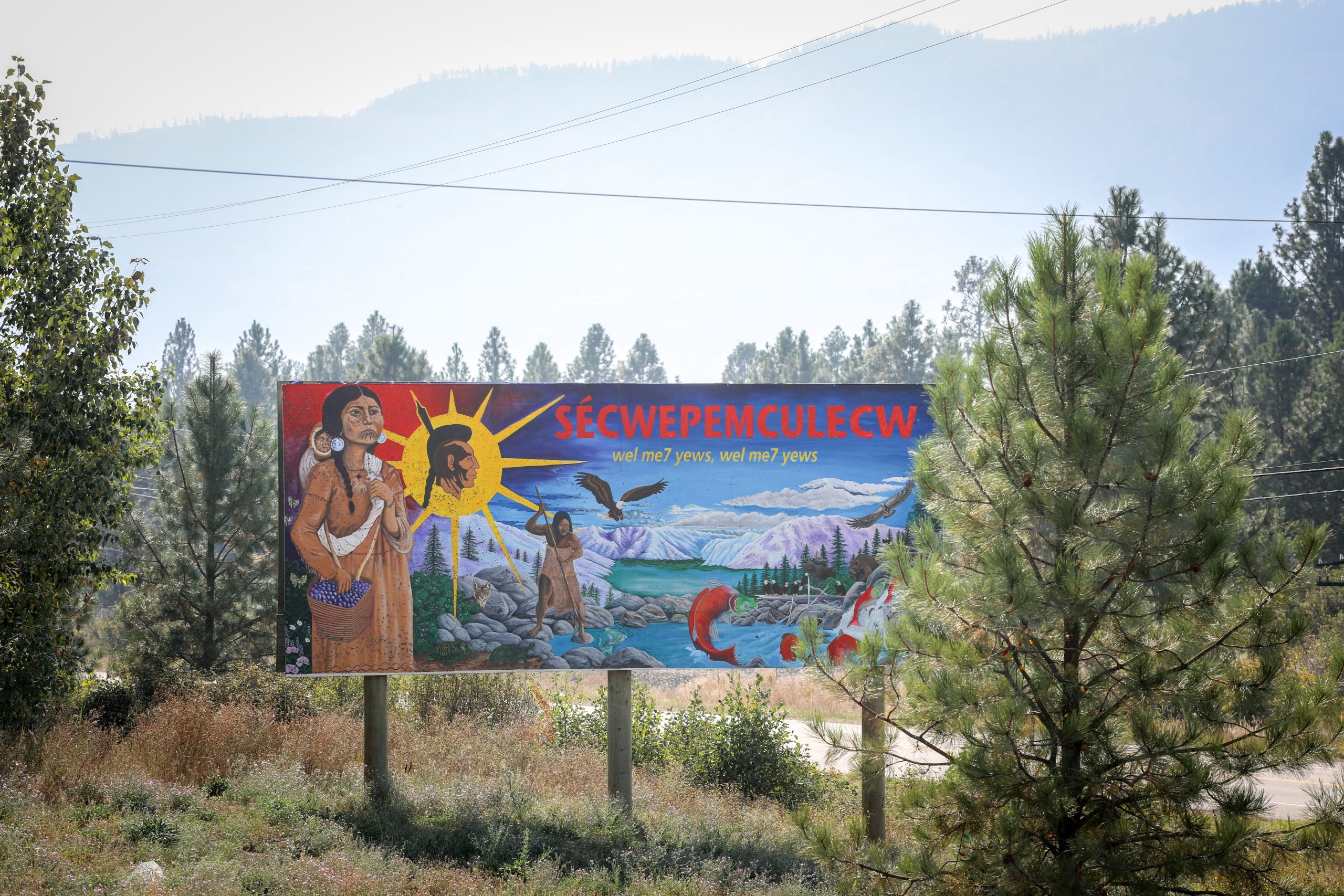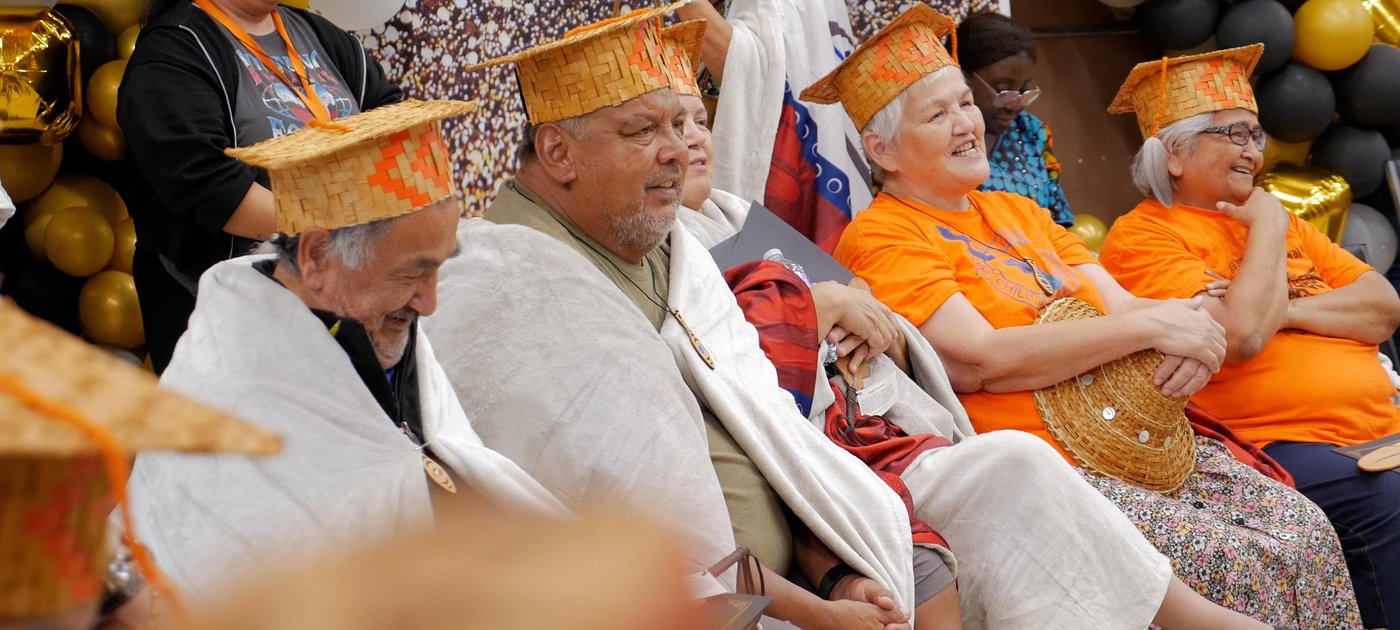‘It’s living, it’s breathing’: Outdoor tours of syilx cultural garden in high demand
Guides at k’nmaĺka? sənqâĺtən share plant and medicine teachings, including the uses of sp’itł’m and smu’xa?an

Tours of a busy cultural garden in syilx homelands are increasing awareness about syilx plants, medicines and stories among both Indigenous and non-Indigenous visitors.
Cultural tours offered at k’nmaĺka? sənqâĺtən (Kalamalka Garden) have helped give the public a better understanding of the culture and history of the syilx Nation since 2018.
“A large part of our history and culture was collecting the medicines and having a relationship with them,” said inskimiheestchin Justen Peters, a member of the Okanagan Indian Band (OKIB) and main tour coordinator at k’nmaĺka? sənqâĺtən.
“I think if we’re going to achieve reconciliation, we need people to understand the importance of the plants and the stories that have been here for thousands of years. I feel like it’s a step in the right direction towards people with the right intentions, but also, creating those relationships.”
k’nmaĺka? was the name of a syilx Hereditary Chief who was once responsible for a village site at the north end of Kalamalka Lake, where modern day “Coldstream” is located. sənqâĺtən means a gathering place for medicines or a place to plant food and herbs.
The garden’s tour schedule has been jam-packed with visits from local schools since May, he said.
“There’s a demand, an interest, and a yearning for people to learn and connect. I really do feel like this gives an authentic Indigenous experience,” he said. “It’s not an indoor museum, it’s outdoors – it’s living, it’s breathing.”
There are 17 different medicines and plants planted in the garden, which is located at Okanagan College’s Vernon campus near Kalamalka Lake. Many of the plants in the garden continue to be harvested and used by syilx people.
During tours, Peters provides the history and significance of each medicine, including siyaʔ (Saskatoon berry), smu’xa?an (arrowleaf balsamroot), and sp’itł’m (bitterroot).
For example, Peters shares that prior to colonization, fresh smu’xa?an heads were brushed over the bodies of young girls in the community as a rite of passage into womanhood.

He added that Elders have said women shouldn’t go out into the forest when they are menstruating because their pheromones may attract other animals such as bears and make them go wild.
“But it’s said that if you brush yourself up, if you get the scent of the smu’xa?an head on you, it covers up that smell and protects women when they’re up in the forest.”
Peters said that to help hunters learn to be quiet on their feet, young men in the community would tie smu’xa?an leaves to the bottom of their feet and see how far they could walk without breaking a leaf.
Grandmothers and grandchildren would go out onto the land and harvest smu’xa?an stems together, Peters noted. Youth would typically peel off the plant’s fuzzy skin to reveal a crisp stem inside, which Peters likens to celery or asparagus.
“I heard this from multiple Elders that every spring, when they see the smu’xa?an blossom and flower, it brings them back to when they were little kids out on the hills collecting it,” he said. “So it has a psychological effect on bringing back good memories and bringing back that connection to the land.”
The smu’xa?an tap root, he continued, resembles a sweet potato that would typically be steam cooked for three days to make it soft, mushy and sweet.
“When you harvest it raw, it’s nearly rock hard and resembles wood, like a chunk of wood,” he said. “But you can still make tea out of it that was said to give you spiritual powers. It’s really rejuvenating, energizing tea.”
Similarly, he said that sp’itł’m also offers a rejuvenating feeling when ingested.

“You peel it right away, eat it right away, it’s kind of sweet like a grapefruit. The longer you leave the skin on, the more bitter it will be,” he said. “(It’s) another medicine that was typically collected by grandmothers, their daughters and their grandchildren.”
siyaʔ, featured in the syilx story of the Four Food Chiefs, would often be mixed with sp’itł’m to make a pudding. Peters said that the berry actually tastes better when dried.

“Within our Four Food Chiefs story, siyaʔ also represents youth and creativity, light energy,” he said.
One of his favourite parts about the job is when youth participating in the tour already have pre-existing knowledge of the Four Food Chiefs and other elements of syilx culture.
“This is sort of an end of the year field trip for a lot of kids, and it feels like an end of the year Indigneous exam where I ask them questions,” he said. “There’s no test or grades but it’s really interesting to see.”
A tour of the garden is open to the public, and can be booked until late August through the k’nmaĺka? sənqâĺtən website.
Peters said that he hopes that anyone who participates in a tour walks away with a deeper appreciation of the territory and the specific plants that grow there.
“So that when they look out to the land, they don’t just see shrubs, bushes, trees and stuff. That they feel like they can have a deeper connection with their environment,” he said.
“And just to acknowledge that the reason why people move here, the reason why people live here, is because of the plants, the animals, the trees, the lakes, the shapes of the hills and essentially the environment; the tmixʷ, all living things, as we say.”
Author
Latest Stories
-
‘Bring her home’: How Buffalo Woman was identified as Ashlee Shingoose
The Anishininew mother as been missing since 2022 — now, her family is one step closer to bringing her home as the Province of Manitoba vows to search for her
-
‘No trust’: Neskonlith members seek answers as tensions climb amid firings, lawsuit
Indigenous Services confirms complaint filed, as Secwépemc community embroiled in allegations of election fraud, ‘civil conspiracy’
-
shíshálh Nation holds grad ceremony to recognize residential, day ‘school’ survivors
The event honoured the life experiences and strength of survivors, with about 50 people being presented with certificates and cedar caps: ‘We see you, and we see how hard you worked’













